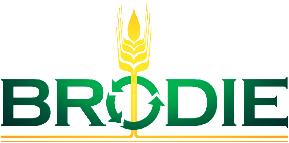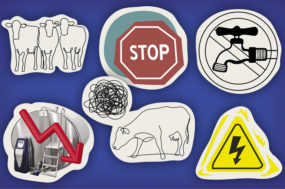Progressive Dairyman Editor Karen Lee asked Doyle to reflect on his nearly four decades at DFC, first serving as assistant executive secretary for 10 years, followed by 28 years as executive director.
Can you describe what the Canadian dairy industry was like when you started at DFC?
DOYLE: Supply management was created in the 1970s. At the time, contrary to what people think about the quota system in Canada, the industry was not self-sufficient.
The quota system was not introduced to control production but rather to share how the market should be proportioned between the provinces to try to stimulate production in the provinces that were maybe less sufficient.
That didn’t work until 1975 when the government decided to regulate the price to reflect the cost of production and all of a sudden milk production surged.
So, when I started in 1976, it was the first time the industry over-produced Canadian demand for milk and, therefore, was subject to a big cut in quota.
I remember a big rally on Parliament Hill in Ottawa where the farmers were faced with an 18 percent cut in production. You can imagine after all the growth they had been trying to achieve this was not particularly welcome in many cases.
There were a lot more producers then compared to now, about six times more. The processing side was far more cooperative-based, which is something we lost in this country significantly over the years. There was a different relationship between processors and producers than there is today.
You also had, at the time, what I call the two milk sources, a distinction between industrial milk and fluid milk producers with a higher quality standard and a higher price for the latter. Today, there is a single quality and returns from the different markets are pooled among producers.
Agriculture was a significant driver of the economy. It still is today but obviously in a much more diverse and different sense.
I arrived at DFC when the Canadian Federation of Agriculture was meeting with the Federal Cabinet. On my first day, I joined the other CFA staff and board members to meet with the prime minister, the minister of agriculture and all members of the Cabinet.
The political environment has changed significantly to today’s reality, where the accessibility to politicians at that level is a bit more difficult.
How is it different today?
DOYLE: Quota has changed the industry significantly. In those years, the structure was very provincial-oriented, and industry development was driven by the province. In today’s reality, it is a national market.
That significant change over the years has had an impact on the rationalization of processing where today only three companies receive more than 75 percent of all milk produced.
The producers also changed. The cream producers that probably outnumbered the milk producers today disappeared over the years. There were more stringent standards to be met at the farm.
Supply management started to establish more control. In 1978, I served as secretary of the national committee that negotiated on behalf of all 10 provinces the agreement on how supply management was actually governed.
It took seven years and the negotiations were very active. The result was the National Milk Marketing Plan, which remains the foundation of the Canadian milk supply management system.
In your opinion, what was the most significant change that took place during that time frame?
DOYLE: Trade agreements that started in the late ’80s and early ’90s, they were probably one of the biggest changes that affected the industry. It forced the industry to have a much bigger look outward rather than just inward.
In 1992, I was responsible for organizing the largest rally of farmers on Parliament Hill over the GATT negotiations. We had 40,000 people on the Hill challenging what was called Article XI, which permitted import controls.
It was a changing time with new challenges that were impacting the entire industry’s future.
At the same time, the industry was looking at its vision. It had gone through the structural arrangements of the 1970s; the 1980s was a time of significant market growth; and the 1990s, with its international trade challenges, was a time for looking ahead at how the challenges would change the future.
In 1992, we had a five-person committee that traveled across the country sharing 20 recommendations on how the industry needed to structure itself from a provincial to a national infrastructure.
More than 20 years later, we’re still debating some of those recommendations, but nonetheless, many were implemented and they impacted how people were looking to the future.
In 1994, Dairy Farmers of Canada merged with the Dairy Bureau of Canada, which was the marketing and nutrition arm of the industry. This resulted in a much bigger portfolio, a much bigger staff and a much bigger budget for me to manage.
What other changes are worth noting?
DOYLE: Pooling is another significant change. National pooling was part of the recommendations proposed in 1992. That didn’t happen as envisioned, but the producers created two pools – P5 and Western Milk Pool – where the farmers are basically subject to pooling the returns of all the markets within their pool and trying to harmonize as much as they can.
Rationalization of the industry is a change that has occurred through the entire time. In the late ’70s, we were losing about 10 percent of the producers per year, which was significant because there was a large amount of producers.
In the ’80s and early ’90s, the industry was happy to grow and only lost 8 percent of the farmers each year. In the late ’90s and early 2000s, it slowed to a loss of 5 percent of the producers every year. Now we’re down to less than 2 percent.
This lower rationalization has also led to a slower rate of growth at the farm, not because the farmer does not want to grow, but because the quota is less available.
This could be one of the biggest challenges in the coming years in how you permit that growth at a business level, while also providing the stability and level of income farmers actually want to have.
What additional challenges exist for today’s industry?
DOYLE: Border control is one. Trade agreements have a tendency of being set in time. As technology evolves, the means for border control that were effective a few years ago may not apply to technology that exists today.
This creates significant problems for an industry that relies on not a closed border but a border that provides predictable imports, which are necessary to plan production.
Unless the government gets a lot more serious about maintaining product border control, which it’s been a little bit slack on, it is going to continue to be a challenge for the system.
We’ve also seen a major rationalization of the processing sector. That has changed the dynamic of the industry. It is much more difficult to see the connection between the producer and the processor.
Describe some of the strengths present in the industry right now.
DOYLE: Having a stable industry compared to a very unstable world market. This also provides us with stability for consumers. While often criticized, it really is one of the biggest strengths of our industry.
Another strength is the structure of the industry with producers acting as a collective group rather than individuals. This continues to give us strength from a lobbying standpoint.
Producers have a network that establishes the same message. To have a platform at that level to reach a consensus from all producers and have this transposed in all the provinces is one of the industry’s biggest strengths.
Looking ahead, how might the dairy industry be different in the next five to 10 years?
DOYLE: I think a drive towards a national market and a national system will continue. Ten years from now, the industry will have to find ways to become more of a national system, where the differences of the provinces can be harmonized. While our strength is our unity, our weakness is our differences at times.
Another significant change we’ll complete in the next 10 years is what we call the proAction Initiative. This is the way of the future. It takes into account all of the social pressures we’re experiencing in the agricultural sector, such as food safety, biosecurity, animal welfare, environment and so on, and places them in a single national system where farms will actually be validated for all of these good practices.
This will be fairly unique. You see some of it in other countries, where a processing plant would dictate a certain protocol for all of its producers. However, in this country, it is going to be 100 percent of producers that will participate in the program. Since milk is co-mingled in this country, you cannot identify producers that are different from the others.
You’re going to have to have 100 percent of all producers on the program. It’s going to be a challenge, but I think it’s going to be awesome for all farmers to be able to say to consumers they are meeting all of the best standards in the world.
What impact will DFC have on moving the industry forward?
DOYLE: I think it will continue to play the leadership role it has had over the years. DFC really is a platform where producers across the country are being brought together and reaching a consensus.
Our staff has grown from the 2.5 when I started to 85 people today. We have a very high professional environment and we have the expertise and quality.
I think as long as farmers continue to have a dialogue and a network where they actually resolve their differences and continue to come to a consensus, then we’re going to continue to be seen as a leader. There is no other forum like this in the country.
Any last thoughts?
DOYLE: For me, it’s been an absolute pleasure. I look back to when I arrived at 21 years old, fresh out of university with a degree in animal biology. I knew nothing about dairy or agriculture for that matter, but I wanted to be a lobbyist.
I guess the foresight of those who hired me saw that it was what they needed, and that was what I’ve become. I’m very proud of it. Some people say it’s a bad thing to be a lobbyist. It’s a necessary thing, as far as I’m concerned, in how our democratic system functions.
I’ve had the privilege of representing dairy producers and representing milk. I couldn’t have asked for anything better. They are great people with great values. It has fed my passion for building this industry and to watch it grow. It has been 38 years of pure joy. I’m very thankful to have been a part of this industry. PD









